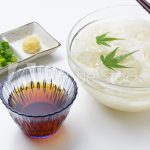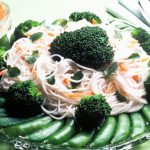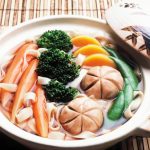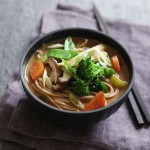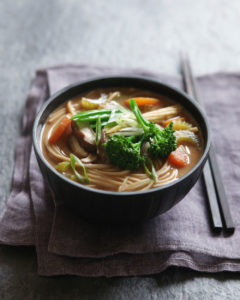
There are a wide variety of Japanese noodles, with the three main types being soba (made from buckwheat), udon, and ramen (both made from wheat). The best way to enjoy Japanese soba or udon is to visit a traditional store where the noodles are made by hand. The taste and texture of fresh hand-made noodles is hard to beat. Taking inspiration from these methods, Mitoku aims to replicate the great taste of traditional hand-made noodles as closely as possible.
-
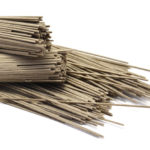
Organic 100% Soba
Mitoku offers a variety of soba noodles, all with the characteristically satisfying flavor and substantial texture of traditional soba. Our 100% buckwheat soba is a hearty, delicious noodle that comes in salt-free and salted varieties. Producing soba with buckwheat alone requires special care and attention, as the noodles can easily become dry and brittle. Our producer is one of only a few in Japan making this hard-to-find variety. We also offer noodles that are 80% soba with the remainder being unbleached white flour.
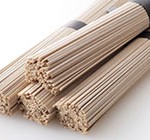
Organic Brown Rice Udon
Although most udon noodles are made entirely from wheat flour, Mitoku’s brown rice udon, developed especially for the natural foods market, adds brown rice flour to the mix, creating a nutritionally wholesome product that is low in fat, high in complex carbohydrates, and contains the complementary amino acids of rice and wheat.
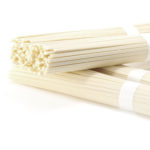
Organic Wheat Udon
Mitoku’s udon noodles are made from a combination of whole wheat and unbleached wheat flour, producing a thick, white-colored noodle resembling linguine. These carefully crafted noodles are soft and chewy with a smooth texture and satisfyingly umami-rich flavor. Udon noodles are easy to prepare and versatile, working well in broths, with dipping sauce, or pan-fried.
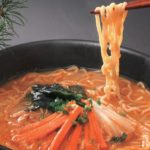
Organic Miso Ramen
Mitoku’s Organic Miso Ramen is a handy complete meal. It combines non-fried ramen noodles, made with just wheat flour and sea salt, with a rich, deep broth that blends the natural goodness of Mitoku’s brown rice miso with the spicy warmth of ginger. This item is free from GMO and agri-chemicals and does not contain any sugar, artificial additives, or animal-derived ingredients. Quick and easy to prepare, Organic Miso Ramen is a great option for a healthy meal when time is limited.

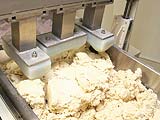
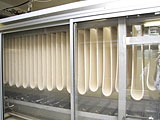
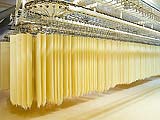
Mitoku’s organic soba and udon supplier has been in business since 1960. Situated near the Isawa River, famed as the most picturesque in northern Japan, in an area blessed with beautiful, clear water and cool, refreshing air, our supplier utilizes these natural resources while drawing on labor-intensive techniques passed down through the generations to produce noodles of the utmost quality.
The noodle-making process begins with the selection and blending of high-quality flour, which should be aromatic with gentle elasticity. Next comes the addition of fresh water from the local river. The water is slowly and firmly kneaded into the dough. For salted noodles, mineral-rich sea salt is added.
When making udon, it important to get a good, thick, chewy texture. To achieve this, the dough must be firmly kneaded then allowed to rest to develop the wheat gluten. Traditionally in Japan, this was done by treading on the center of the dough to release air from the mixture, giving it a stronger texture. Nowadays, the same result is achieved by pressing the dough mechanically. Because soba contains either small amounts of wheat or no wheat at all, this additional process is not required. In addition, if soba noodles are dried for too long, they will become brittle and discolored. For this reason, soba is produced over a shorter time period than udon.
After the dough has been formed, it is passed through a series of rollers to form long, continuous sheets with even consistency. The sheets are then allowed to rest without being pressed, which deepens the umami flavor. Once this step is completed, the sheets are cut into long, thin strings called mensen, which are matured for a further five hours until they begin to dry.
One of the most important elements in producing umami-rich, delicately textured noodles is the final drying process. The mensen are taken to a special drying room, where they are suspended from rods and allowed to dry gently and gradually over the course of about 24 hours. This slow drying process provides the noodle with superior depth of flavor. Lastly, the dry strings are cut into different sizes and packaged, and, once the final checks have been carried out, the product is ready.
During the heat of summer, noodles are deliciously refreshing when served floating in a bowl of ice water and accompanied by a chilled dipping sauce. For warmth in the winter, noodles are commonly served in piping hot broth. Whether in soups or salads, sautéed with vegetables, deep-fried, baked, or topped with sauce, noodles are delicious.
Quick to prepare, they provide the perfect solution when you have unexpected guests. In the time it takes for the water to boil and the noodles to cook, you can prepare a broth or sauce and a vegetable dish and voila! In twenty minutes you can create a nutritious and satisfying meal.
Since most Japanese noodles are made with salt, it is not necessary or advisable to add salt to the cooking water. In a large pot, bring the water (about ten cups of water for every eight ounces of noodles) to a full rolling boil. Add the noodles a few at a time so as not to completely stop the boiling. Stir gently until the water is boiling rapidly again to prevent the noodles from sticking to the bottom of the pan. If too many noodles are added at once, the water will not quickly return to a boil and the noodles will be overcooked on the outside and undercooked on the inside. Also, using too little water will result in sticky, unevenly cooked noodles.
There are two acceptable methods for cooking noodles. The first method is quite basic. Simply bring the water in the pot back to a rapid boil once all the noodles have been added (as just described), then cook the noodles over medium heat until done. The second method is known as the “shock method”. Once the noodles have been added to the pot and the water returns to a rolling boil, a cup of cold water is added to “shock” the noodles. When the water returns to a boil again, another cup of cold water is added. This is repeated three or four times until the noodles are cooked. No matter which method is used, noodles should be tested often to avoid overcooking. A properly cooked noodle should be slightly chewy. When broken in half, the noodle should be the same color throughout.
Once cooked, immediately drain and rinse the noodles in two or three cold-water baths or under cold running water to prevent further cooking and to keep the noodles from sticking together. When they have cooled enough to handle, drain and set aside until ready to assemble your dish. If reheating is necessary, place individual noodles in a strainer or colander and submerge in a pot of boiling water until just heated. Drain well and serve.
The noodle cooking water can be reserved, allowed to sour slightly, and then used as a natural leavening agent in breads, muffins, and pancakes.
Related Recipes



